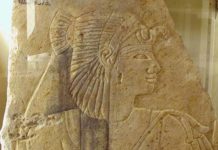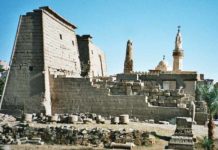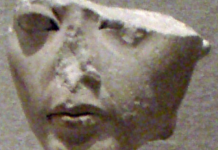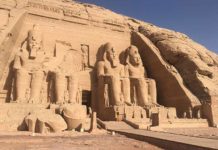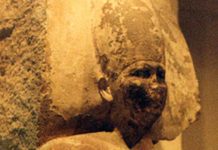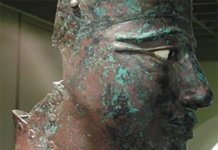Tutankhamun was a relatively unimportant king who ruled for ten years at the end of the 18th dynasty, after the Amarna Period.
Tutankhamun’s tomb lay undisturbed for centuries in the Valley of the Kings until its remarkable archaeological discovery by Howard Carter and the Earl of Carnarvon on 4 November 1922. Priceless treasures—everything Tutankhamun needed for his journey during the afterlife—were still in place when the tomb was opened, including chariots, gloves, gauntlets and a large supply of wine.
Amarna
He was born Tutankhaten in 1341BC, the son of Amenhotep IV (later Akhenaten) but his mother was not known. Many historians suggest his mother was Kiya, a secondary wife portrayed in a funerary bier. He was heir to an immense kingdom stretching north to the Euphrates River and south to the Fourth Cataract of the Nile. Tutankhamun was the last of a line founded by warrior Pharaohs.
Egypt was a superpower for almost two centuries until his father, the “heretic” Pharaoh, changed the state religion of Egypt, closing down the great gods’ temples, and dedicated them to the sun-disk Aten.
The boy Tutankhaten spent the first nine years of his life at Amarna and probably lived in the Northern Palace with his stepmother Nefertiti and the other royal women. He grew up alongside his half-sisters, and he received a traditional royal education consisting of reading, writing and trained to become a warrior, as he learnt the necessary skills of warfare.
The Boy King
Tutankaten was about nine when his father died during the seventeenth year of his reign. He changed his name to Tutankhamun and moved the royal court back to Thebes where he was crowned Pharaoh in a traditional ceremony.
He rejected Akhenaten’s teachings, brought back the traditional religions and restored the power and wealth of Amun. However, Tutankhamun depended on advisors as he was still a minor, especially Horemheb (the army’s Commander-in-Chief) and an elderly vizier Aye who held the ambiguous title of God’s Father.
Aye and Horemheb took principal responsibilities for major decisions made during Tutankhamum’s minority. Tutankhamum was determined to restore Egypt back to its former glory, as plans were drawn up re-establishing cults, traditions, temples, shrines and festivals.
Tutankhaten married his half-sister Ankhsenpaaten (later Ankhesenamun), the third daughter of Akhenaten and Nefertiti, when he was about ten years old. She was six to eight years older. Scenes of intimacy decorated the tomb which may provide evidence of real affection, even love, between the royal pair.
They produced two daughters whose foetuses were buried alongside Tutankhamun in a plain white wooden chest. One was miscarried at five months, whilst the other was born prematurely at seven months, and died shortly afterwards. The larger foetus suffered from genetic abnormalities including spina bifida and scoliosis.
He was an extremely active sportsman, contrary to previous assumptions he suffered from scoliosis. (Modern-day doctors believed the bend in his spine was caused by the embalmers who positioned his body as they prepared it for burial.)
Foreign relations had deteriorated during his father’s reign as the Amarna Letters refer to chaos and turmoil, which reflected the changing balances of power. Vassal kings pleaded with Akhenaton for protection against their neighbours as kings begged for alliances and gold.
Tutankhamun’s principal allies and main rivals for regional supremacy were the Hittites in Hatti (modern-day Turkey and Syria), the Babylonians and Assyrians (Iraq) whilst the Mycenaean Greeks dominated the Aegean.
Two battles occurred later during his reign. The first was against the Nubians in the south, and the second was a victory against Asiatics—with a triumphant river procession to Thebes. It is not known whether Tutankhamun, due to his age, actually participated in these battles.
A Chariot Accident
Tutankhamun died unexpectedly in January 1323BC, aged nineteen, but no records survive of his last days. Scientists now believe Tutankhamun was killed in a chariot accident, rather than a blow to the head.
A CT scan of Tutankhamun’s body in 2005 revealed he was in good health, with a broken right knee cap and a fracture in his lower left leg, indicating he suffered an accident before his death. Tutankhamum may have died from a life-threatening infection after his injury. The present-day Lord Carnarvon believes Tutankhamum could have easily broken his leg if his chariot, moving at a fast speed, had overturned.
He was 170cm (5 feet 6 inches) in height and Tutankhamun was in good health. A head scan revealed Tutankhamun may have suffered pain from an impacted upper-left wisdom tooth and sinus problems. He had large frontal incisors, a substantial overbite inherited from his Tuthmosid ancestors, slightly misaligned lower teeth and a slight cleft palate.
Aye seized power after Tutankhamun’s death, so Ankhesenamun sought marriage with Hittite prince Zennanza, but he was murdered before he reached the Egyptian border. She was forced to marry Aye.
Sources:
- Booth, Charlotte, People of Ancient Egypt, Tempus Publishing Ltd, Stroud, 2006 [Reprinted 2007]
- Connor, Steve, A 3000-year-old mystery is finally solved: Tutankhamum died in a hunting accident, The Independent, 22 October 2007
- Hawass, Zahi, Tutankhamun and the Golden Age of the Pharaohs, National Geographic, Washington DC, 2005



